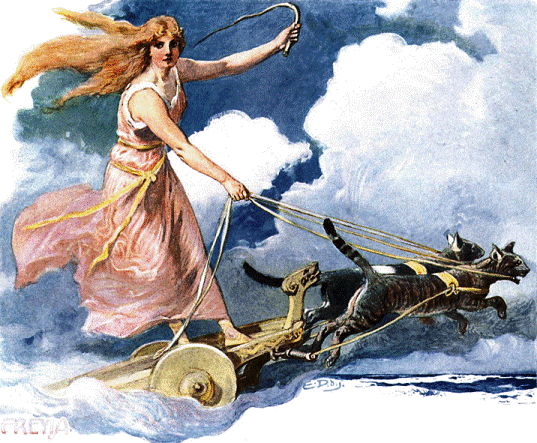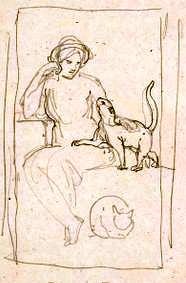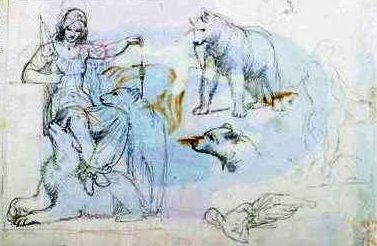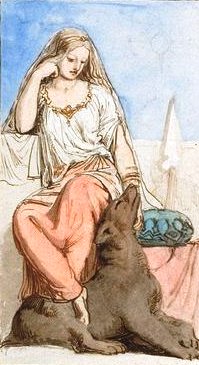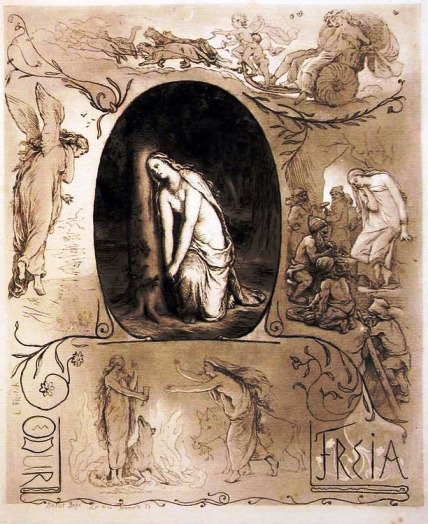|
|
|
In the historical scholarship, there seems to be some
question as to what kind of animals drew Freyja’s car. While
most scholars today accept that Freyja's car was drawn by cats,
that cannot be definitively determined from the sources.
Although it is rarely mentioned today, the topic was much
discussed by Eddaic scholars in the middle of the 19th
century.
|
In 1829, Finnur Magnussen first broached the subject,
stating:
| Eddaerne
tillægge Freya undertiden et Forspand der snart
siges at have bestaaet af Katte, snart Fress', denne
sidste Benævnelse tillægges nit i Island Hankatte,
men vi see af Skalda at det og fordum har betydet
Bjöme , samt rimeligvis da ogsaa andre her i Norden
ubekjendte glubende Dyr, som Löwe og Tigre (af mange
regnede til Kattearten) o. s. v. Det Islandske Navn
for en Löve Ljón (Leon) maa udledes fra Latin eller
Græsk. |
Sometimes the
Eddas give
Freya
a team that is now said to have
consisted of
cats, now
'fress'. This
last
designation in Iceland
is conferred on tom-cats,
but we see that to the
skalds it
formerly meant bear
and
probably then here too in
the North other unknown
ravenous
beasts, like lions
and
tigers (of many reckoned
among the
cat
species) etc. The
Icelandic
name for lion
Ljón
(Leo) must
be derived
from
Latin or
Greek. |
In 1832, Svend Grundtvig raised the topic again:
Herpaa hentyder
da ogsaa det stygge Katte-Spand, som Gylfe-Legen
tilskriver hende *), skiöndt jeg er nær ved at troe,
det er en Islandsk Foræring, istedenfor to Bjarne.*
*Freya kaldes nemlig i Skalda
(p. 119) blandt Andet eigandi fressa, og betyder nu
"fress" som Bjårn Haldorsen siger, baade en Kat og
en Björn,
da lader jeg Kattene löbe, og
spænder Björnene (Kæmperne) for. |
Then here too refers the tom-cat team, that Gylfaginning
attributes to her, I am close to
believing is an Icelandic bestowal,
instead of two bears...
*Freyja
in
Skáldskaparmál (p.
119)
among other things is
called eigandi
fressa,
and now
"fress" means,
as Björn
Haldórsson
says,
both a cat
and a bear,
I let the cats run and yoke the bears. |
Jakob Grimm discusses
the matter in his Deutsche Mythologie (1844),
later translated into English by James Stalleybrass (1883).
Grimm remarks:
|
Der Freyja wagen war mit zwei katzen (tveimr
köttum) bespannt (s. 282); da altn. fres nicht
blofs kater sondern auch bär bedeutet, hat man neulich
gar nicht uneben behauptet, köttum könne aus
fressum entprungen,
und ein bärengespann der göttin gemeint sein.
|
“Freyja's car was drawn by two
cats (tveim köttum), p. 282. Now,
as fres in ON means both he-cat and bear, it has
lately been contended, not without reason, that köttum
may have been substituted for fressum, and a
brace of bears have been
really meant for the goddess, as
Cybele's car was drawn by lions.
|
In 1857, this was
argued against by Johann W. Wolf
in
his Beiträge zur Deutschen
Mythologie, Vol. II, who states:
|
Grimm scheint M. 634 nicht ganz abgeneigt, die meinung
zu theilen, da altn. fres kater und bär bedeutet, so
könne köttum aus fressum entsprungen sein, und Freyjas
wagen wäre statt mit tveimr köttum, ähnlich dem
löwenbespannten der Kybele mit zwei bären bespannt
gewesen. nach dem was 1, 186 über die katzen und vorhin
über den bären beigebracht wurde, scheint diese ansicht
jedoch kaum haltbar. Ebenso spricht dagegen, dass wir
die katze als pförtnerin, als dienerin der thierkönigin
genannt finden, dass kobolde und zwerge, über die
Holda-Freyja zu herrschen scheint, in katzen gestalt
auftreten, dass teufel und hexen auf katzen reiten. Das
bauernweib, das nach dem Blocksberg will, bestreicht
zuerst ihres grauen katers, dann ihre füsse mit salbe,
worauf jener zum grauschimmel wird (das. 68.). |
Grimm
(DM p. 634) seems not entirely averse to share the
opinion, because Old Norse fres means
cat and bear, that köttum might have sprung
from fressum, and Freyja's wagon drawn by
tveimr köttum, was pulled by two bears
similar to Cybele's span of lions. After what
was said in 1, 186 about cats and
earlier about bears, this seems hardly
tenable. Equally, however, is the fact that we find the
cat as a gatekeeper; as the handmaid to the queen of
animals; that kobalds and dwarves, over which
Holda-Freyja rules, appear in the shape of cats; that
devils and witches ride on cats. The peasant woman who
would go to Blocksberg, first smears her gray tomcat,
then her own feet with salve, whereupon appears a gray
horse (ibid. 68). |
Wolf suggests that because the cat was
associated with witches, as Freyja herself was, that
Freyja's association with cats originated within the heathen
era. Although he is probably correct in this, even this
reasoning didn't quell the opposition. In 1864, P. D. A.
Atterbom expresses the opinion that:
Freya,
åkaude genom himlarymden efter
sitt björnspann*), gjuter gullregnet af sin längtans
tårar.
*Det
isländska ordet "fress", som allmänligen tolkats med
katt,
betyder äfven
björn: se isländaren Björn Haldorsens
lexicon. |
Freya, riding
through heaven after her bear-span,* emits
the golden rain of her tears of longing.
*The Icelandic word "fress" that is generally
interpreted with cat, also means bear: see Icelander
Björn Haldorsen's lexicon. |
This
discussion also seems to be the inspiration for some of the early
sketches for Freyja made by
Lorenz Frølich around 1844, who portrays the goddess
with both bears and cats.
By 1885, the same artist clearly portrays Freyja in a car
drawn by cats, probably reflecting the then-current
scholarly arguments (top panel).
The theory seems to have died out around the same time. Thus
it appears that the debate concerning the species of
Freyja's draught-animals ran from some time around 1829 and
lasted until around 1870.
The argument, which clearly
originates in the Old Norse sources (see below), may have
been fueled by the discovery of Gallo-Roman statue of a bear
goddess in Switzerland in the early 1830s, which has been
described as follows:
|
"In 1832 a statuette of a goddess, Artio, was discovered in
the neighbourhood, which dated from Roman times. Now Artio
is certainly connected with Irish art, Lat. ursus,
Gr. aprros, and means the goddess of the bear or
something of that sort. A bear was also discovered among the
other statuettes, but was not until later brought into
connexion with the goddess, before whom it was standing in
the original form of the group." —Encyclopedia of Religion
and Ethics (1908) ed. by James Hastings
“The names Arthur and Artio mean "bear." In
similar fashion, the city of Bern, Switzerland, arose from
the center of a cult of the bear as Mother. The people there
still take her as their symbol. In 1832 in Muri, near Bern,
an ancient statue of Dea Artio, the Bear goddess,
was unearthed from the vegetable patch of a local parson.
The arresting bronze statue shows the seated deity offering
fruit in a paterna dish to her bear.” —Lady of the Beasts
(1994) by Buffie Johnson.
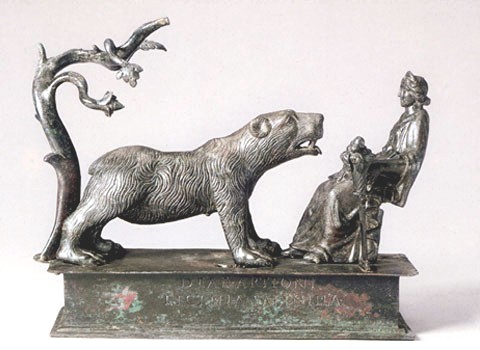
|
Despite
the debate, it should be noted that artists throughout the
length of the scholarly discussion continued to depict Freyja (or
Frigg, due to the persistent confusion between the two goddesses) in
a car drawn by cats. This suggests that the theory about the
bears was never widely
accepted.
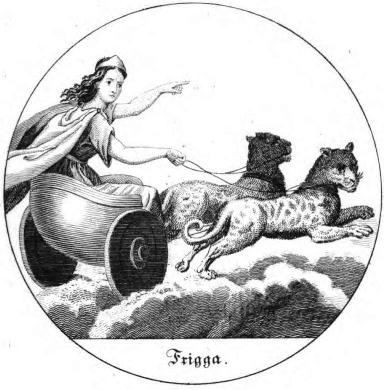
1829 Anton Thormond Legis |
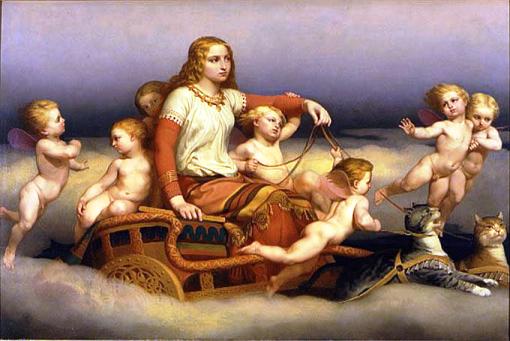
1852 Nils Blommér |
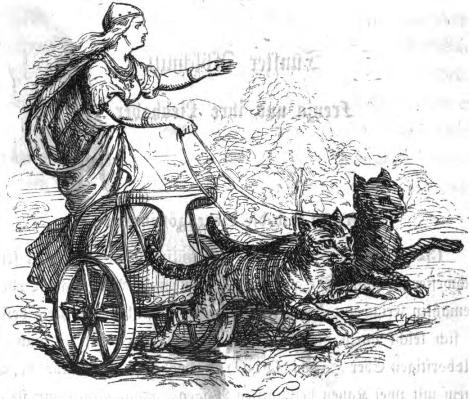
1865 Ludwig Pietsch
|
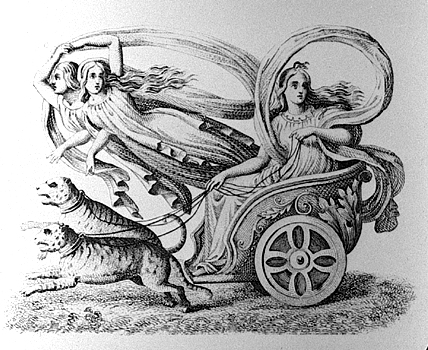
c. 1869 George Eastman collection |
|
So what instigated such an unusual
discussion in the first place? Before we dismiss these
observations as spurious, it’s important to look at
the sources. Freyja’s car is not mentioned in the Poetic Edda.
The question arises from the words used for her draught-animals
by Snorri Sturluson in the Prose Edda, where they are mentioned three
times: once in
Gylfaginning 24 and again in Gylfaginning 52, then again in Skáldskaparmál 28.
|
Gylfaginning 24: En er hon ferr, þá ekr hon köttum
tveim ok sitr í reið. |
(Anthony Faulkes tr.) "And when
she travels she drives two cats and sits in a chariot."
|
Freyja drives the same team to Baldur's funeral pyre:
|
Gylfaginning 52:
En þessa brennu sótti margs
konar þjóð, fyrst at segja frá Óðni, at með honum fór
Frigg ok valkyrjur ok hrafnar hans, en Freyr ók í kerru
með gelti þeim, er Gullinbursti heitir eða Slíðrugtanni,
en Heimdallr reið hesti þeim, er Gulltoppr heitir, en
Freyja ók köttum sínum.
|
(Rasmus Anderson tr.) "First
of all came Odin, accompanied by Frigg and the valkyries
and his ravens. Frey came riding in his chariot drawn by
the boar called Gullinbursti or Slidrugtanni. Heimdall
rode his steed Gulltop, and Freyja drove her cats."
|
While Gylfaginnning says that her car was drawn by köttum,
Skáldskaparmál, in a list of kennings for the goddess, says
that she is the owner of fressa. The
meaning of the latter word is the source of the meaning "bear."
The word appears in a list of bear-names attached to
Skáldskaparmál:
|
Þula: Björn,
bersi, blómr, bera elgviðnir, blájaxl, ísólfr ok
breiðvegi, bestingr, bassi, balti, hlébarðr, úfr, frekr,
vilnir, jórekr, mösni, fetvíðnir, húnn, fress,
vetrliði, íugtanni, jálfúðr, ifjungr,
vilskarpr |
Bear, grizzly, mighty one, she-bear, elgviðnir,
dark-tooth, ice-wolf and broadway, haltered, bassi,
growler, leopard, rough, greedy one, robber, Iorek,
mosni, forest-walker, cub, snarler,
winter-survivor, greedy-tooth, yellow-bum, hooded one,
shrivelled-gut |
In the translation above by Anthony Faulkes (1988), he
defines fress as "snarler." In the glossary that
accompanies his edition of Skáldskaparmál, Faulkes clarifies the term as meaning
"tom-cat", indicating that it designates a bear, and may
literally mean "hisser or snarler(?)"
Richard Cleasby and Gudbrand Vigfusson define the word fress
this way:
FRESS, m. a tom-cat, Edda 63, Grág. i. 501; also called
fress-köttr, m., and steggr, q.v. : — a bear, Edda (Gl.), Kormakr
(in a verse).
Sveinbjörn Egilsson in his Lexicon Poeticum indicates
that fress is found among the bear-names in the thular,
as well as in Grettis Saga 2, 5 as part of the kenning "fangvinar
Hafla fress" (Halfi's challenger's bear) which means "Thor’s bear"
and serves as a paraphrase of
the name þórbjórn; and in a kenning found in a loose verse by
the skald Kormakr, sónar fress, which literally means
"blood’s bear" and designates a sword.
"[Rudolf] Meissner listed only one
name-kenning from Kormakr: the poet's oblique reference to
Steingerðr's first husband, Hólmgöngu-Bersi (bersi
'bear'), as híðbyggvir 'den-dweller, bear' (26).
Kormakr seems to have enjoyed developing the literal idea or
image conjured up by this animal personal name.
In one remarkable display of technical
virtuosity,
he portrays the enraged Bersi running
into single-combat while his own sword, also personified as
a bear, races snarling out of its sheath: greipar
iugtanni 'tusk-tooth (bear) of the grip';
sónar fress 'bear (tom-cat) of
blood'"
—Mediaeval Scandinavia,
Vol. 3 (1971).
In the Lexicon Islandico-Latino-Danicum by Björn
Halldórsson (1814), referenced by Atterbom above, fress is
defined as both a felis, 'tom-cat' and an ursus,
'bear'. The same source is referred to by Svend Grundtvig in 1832.
Thus the word fressa, as defined by Halldórsson, most
likely sparked the debate concerning the species of Freyja's
draught-animals.
Coupled with the word köttum, the use
of the word fressa indicates that Freyja's
car was pulled by a pair of tom-cats (rather than the kittens or
female cats sometimes shown). Apart from fressa,
however, the word köttum also opens up other
possibilities. Could it be that Freyja’s car was once conceived
of as drawn by a
pair of martens? The Cleasby-Vigfusson Dictionary defines the
word as:
|
| |
KÖTTR, m., kattar, ketti,
pl. kettir, acc. köttu, mod. ketti;
[Anglo-Saxon and English cat; Old High German
chatza; German katze; Danish kat;
Swedish katt] :-- a cat, originally the martin cat
or weasel; ... a tom-cat is called fress, högni,
steggr; a she-cat, bleyða; a black tom-cat,
kolr; a white tom-cat, mjaldr; the pet
name is kisa, kis kis, q.v.; hreysi-k.
(q.v.), the ermine cat. It seems that in the Saga time (10th
century) the cat was not yet domesticated, for passages such
as Vd. ch. 28, Eg. S. Einh. ch. 10, and the story in Edda
(Thor lifting the giant's cat) apply better to the wild cat
or the martin cat; and the saying in Ísl. ii. l.c. (sees the
cat the mouse?) probably refers to the weasel and the field
mouse; but that early in the 12th century the cat was
domesticated even in Iceland is shewn by the story of the
chess-players and the kittens leaping after a straw on the
floor, told in Morkinskinna 204, 205.
|
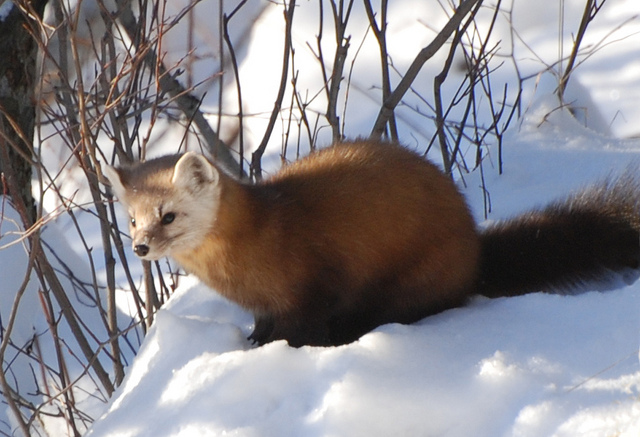 |
As
Cleasby-Vigfusson suggest, the exact meaning cannot be
determined from other usages in the Prose Edda. The word appears
two more times in context in Gylfaginning.
In Gylfaginning 24, the chain Gleipnir, used to bind the Fenris
Wolf, is said to be made of:
|
Hann var gerr af sex hlutum: af dyn kattarins ok af
skeggi konunnar ok af rótum bjargsins ok af sinum
bjarnarins ok af anda fisksins ok af fugls hráka. |
“It
was made of six things: the noise a cat makes in
foot-fall, the beard of a woman, the roots of a rock,
the sinews of a bear, the breath of a fish, and the
spittle of a bird.” |
Of course, the footfall of marten is as soft as that of a cat.
The same word is used of Utgard-Loki's housepet in Gylfaginning
46:
Þá
mælti Útgarða-Loki: "Þat gera hér ungir sveinar, er
lítit mark mun at þykkja, at hefja upp af jörðu kött
minn, en eigi myndak kunna at mæla þvílíkt við Ása-Þór,
ef ek hefða eigi sét fyrr, at þú er miklu minni fyrir
þér en ek hugða."
Því næst hljóp fram köttr einn grár á hallargólfit ok
heldr mikill, en Þórr gekk til ok tók hendi sinni niðr
undir miðjan kviðinn ok lyfti upp, en kötttrinn beygði
kenginn, svá sem Þórr rétti upp höndina. En er Þórr
seildist svá langt upp sem hann mátti lengst, þá létti
kötturinn einum fæti, ok fekk Þórr eigi framit þenna
leik meir.
Þá mælti Útgarða-Loki: "Svá fór þessi leikr sem mik
varði. Köttrinn er heldr mikill, en Þórr er lágr ok
lítill hjá stórmenni því, sem hér er með oss. |
"Then said Útgarda-Loki: 'Young lads here are wont to do
this (which is thought of small consequence): lift my
cat up from the earth; but I should not have been able
to speak of such a thing to Ása-Thor if I had not seen
that thou hast far less in thee than I had thought.'
Thereupon there leaped forth on the hall-floor a gray
cat, and a very big one; and Thor went to it and took it
with his hand down under the middle of the belly and
lifted up. But the cat bent into an arch just as Thor
stretched up his hands; and when Thor reached up as high
as he could at the very utmost, then the cat lifted up
one foot, and Thor got this game no further advanced.
Then said Útgarda-Loki: 'This game went even as I had
foreseen; the cat is very great, whereas Thor is low and
little beside the huge men who are here with us.' |
Although the common housecat is probably intended here, as
Cleasby-Vigfusson point out, the supple, serpentine form of a
marten would work just as well, combined with the fact that
martens are sometimes kept as pets. Since Snorri’s source of
this information is unknown to us, it is impossible to determine
the original word for Freyja's team. If köttum is
the original word, it is also entirely
possible that the species of animal changed as the language
changed, using the designation of a wild animal for the newly
domesticated housecat.
For the car to be
drawn by bears, the word köttum would have to be an
innovation by Snorri Sturluson, the author of the Prose
Edda, based on the word fressa, which he found in his
sources (as Grimm suggests). But since we don't know
Snorri's source for this information, there is simply no way to
tell what the original word for Freyja’s draught-animals was.
Based on the available evidence, Freyja most likely rode in a car drawn by a
pair of tom-cats (köttom, fressa), either domestic or
wild. A likely breed is the Norsk skogkatt or Norwegian
forest cat.
| |
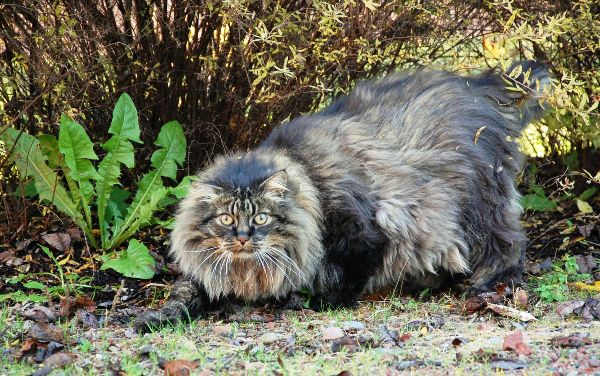
Norsk skogkatt |
|
If bears (or any other creature) ever drew Freyja's car, they
must remain an interesting footnote in the history of Eddaic
scholarship.
|
A pictorial
history of Freyja's car drawn by cats can be found
HERE.
|
|
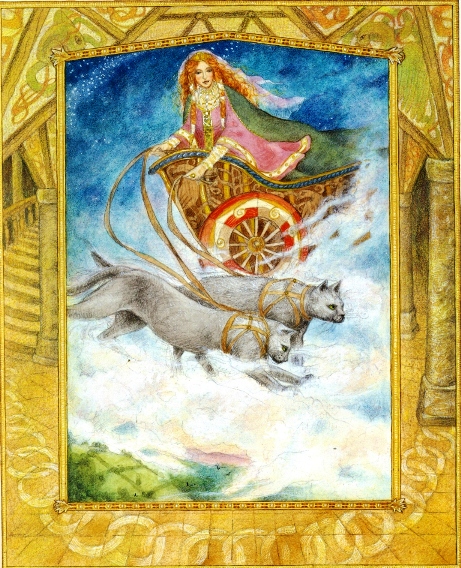
1995 Kris Waldherr |
|
|
|
|
